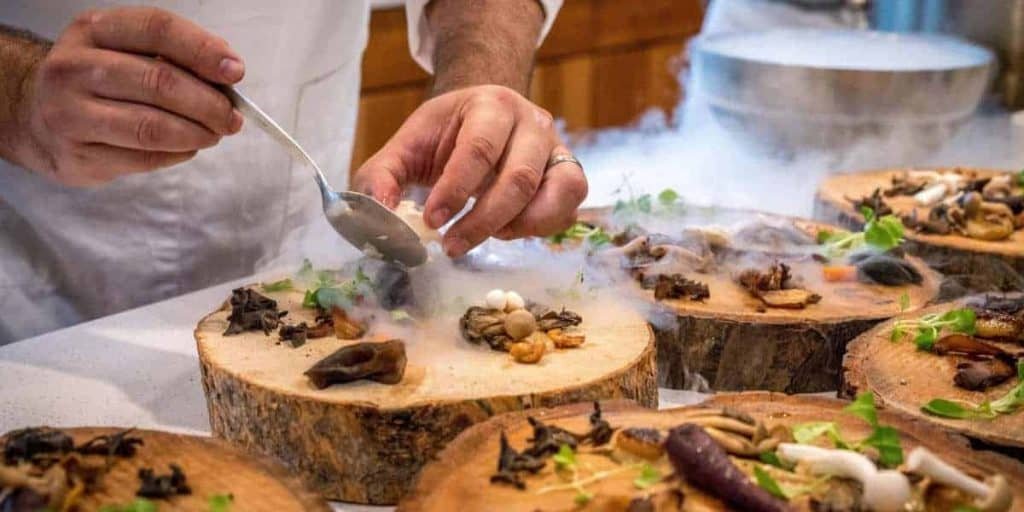Selling At Restaurants
Working with chefs and selling at restaurants allowed me to double my production from one year to the next. The first year I started I worked with only a few restaurants, as it was difficult to keep up to their demands on a weekly basis. This is why I advise working only with one or two when you’re starting out, and smaller restaurants as well.
You need to be careful to not take on too much at the start, because you’re learning the basics of maintaining a steady weekly production system. If you overload yourself, you’ll be letting down customers; I always find that it is better to under-promise and over-deliver than the other way around.
The balance between what the market demands, and what you’re able to produce on a consistent basis is the equilibrium you want to strive for. What makes a great farmer for a chef is not being able to show up every now and then with some great-looking product, but being able to work with them every week, to bend and flex to their demands as they change.
Chefs who have some experience with farmers are great to work with because they like being limited by the season. That’s what keeps their work interesting for them, but you still want to be as consistent as you can.

From a production standpoint, the best thing about selling to restaurants is that you can produce a lot more of the same thing and sell it all in one shot. For example, let’s look at one crop. I can sell up to 200 pounds of radishes per week.
In my farmers markets, I wouldn’t be able to sell that much of one particular crop. I’m lucky to sell ten bunches at a farmers market. To sell those 200 pounds, it might just be a couple of deliveries to restaurants done in an hour or less. That’s $1,000 of product very quickly.
On my farm, restaurants account for the vast majority of our sales. From a purely economic standpoint, selling to restaurants is far less work and more profit when time is factored in, because of the amount of product you can move at once, and the fact that once you deliver it, you’re done and not standing at a farmers market all day.
You do need to be careful because working with restaurants also brings a lot of risk. The main challenge is that if you lose a customer for whatever reason, that can deal a pretty heavy blow to your weekly income.
Other Tips For Selling At Restaurants For Urban Farmers
Selling produce to restaurants as an urban farmer can be a great way to connect with local chefs and provide them with fresh, local, and organic produce. Here are some tips to effectively sell your produce to restaurants:
- Quality is Key:
- Ensure your produce is of high quality, fresh, and visually appealing. Chefs value quality ingredients to create delicious dishes.
- Understand Local Seasonality:
- Offer produce that is in season. Local, seasonal produce is often preferred by chefs for its flavor, sustainability, and cost-effectiveness.
- Build Relationships:
- Establish relationships with chefs, kitchen managers, or procurement staff. Visit the restaurants to introduce yourself and your produce.
- Create a Product List:
- Develop a clear product list detailing the types and quantities of produce you offer, along with prices. Keep it updated and easily accessible.
- Offer Unique Varieties:
- Grow unique or heirloom varieties that chefs may not find from larger suppliers. Differentiation can be a selling point.
- Sample Your Produce:
- Offer samples of your produce to chefs. Let the quality and taste of your products speak for themselves.
- Pricing Strategy:
- Research market prices and set competitive yet sustainable prices for your produce. Be transparent about your pricing and any special offers.
- Consistent Supply:
- Ensure a consistent and reliable supply of produce to meet the demands of the restaurants. Establish a reliable delivery schedule.
- Packaging and Presentation:
- Package your produce in an attractive and functional manner. Chefs appreciate convenient and well-presented packaging.
- Offer Delivery Options:
- Provide delivery services to make it easier for the restaurant to access your produce.
- Communicate Availability:
- Regularly communicate what’s in season and available. Send out newsletters or updates to keep the chefs informed.
- Be Flexible and Reliable:
- Be open to accommodating special requests and last-minute orders. Reliability and flexibility are key in the food service industry.
- Promote Locally:
- Utilize social media, local food directories, and farmer’s markets to promote your produce. Highlight your partnerships with restaurants.
- Educate about Urban Farming:
- Share information about your farming practices, sustainability initiatives, and the benefits of supporting local, urban agriculture.
- Request Feedback:
- Ask for feedback on your produce and service. Use this feedback to continuously improve and tailor your offerings to meet the needs of the restaurants.
Building and maintaining strong relationships with local restaurants is essential for a successful urban farming business. Providing excellent products, excellent service, and being a reliable partner can help you thrive in this market.
Conclusion
In conclusion, selling produce to restaurants as an urban farmer involves a delicate blend of cultivating high-quality, seasonal, and unique offerings while fostering strong relationships with chefs and kitchen staff. T
he key ingredients for success lie in understanding local seasonality, presenting a diverse and appealing product list, offering competitive yet sustainable pricing, and ensuring a consistent and reliable supply.
It’s essential to communicate effectively, maintain flexibility, and prioritize excellent customer service to meet the unique needs of the restaurant industry.
By embracing these strategies and approaches, urban farmers can not only grow their business but also contribute to a more sustainable and locally-driven food ecosystem.
Originally posted 2020-09-01 11:41:56.



